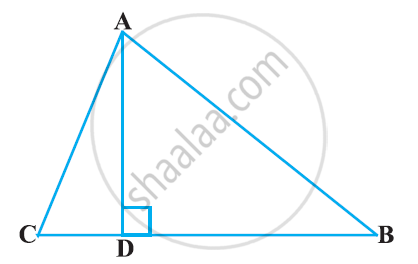Advertisements
Advertisements
प्रश्न
Prove that (1 + cot A - cosec A ) (1 + tan A + sec A) = 2
उत्तर
We have to prove (1 + cot A - cosec A ) (1 + tan A + sec A) = 2
We know that, `sin^2 "A" + cos^2 "A" = 1.`
So,
`(1 + cot"A" - "cosec""A")(1 + tan "A"+ sec "A") = (1 + (cos"A")/(sin"A") - (1)/(sin"A"))(1+(sin"A")/(cos "A")+(1)/(cos"A"))`
= `((sin"A" + cos "A"-1)/(sin"A"))((cos"A" + sin"A"+1)/(cos"A"))`
= `((sin "A" + cos"A" - 1)(sin "A"+ cos"A" + 1))/(sin"A" cos"A")`
= `{{(sin "A" + cos "A")-1} {(sin"A" + cos"A")+1}}/(sin"A" cos"A")`
= `((sin "A" + cos "A")^2-1)/(sin"A" cos"A")`
= `(sin^2 "A" + 2sin "A" cos"A"+ cos^2 "A"-1)/(sin"A" cos "A")`
= `((sin^2 "A" + cos^2 "A") + 2sin "A" cos "A" - 1)/(sin "A" cos"A")`
= `(1 + 2sin "A" cos "A" - 1)/(sin "A" cos "A")`
= `(2sin "A" cos "A")/(sin "A" cos "A")`
=2
Hence proved.
संबंधित प्रश्न
ABC is a right triangle right-angled at C. Let BC = a, CA = b, AB = c and let p be the length of perpendicular from C on AB, prove that
(i) cp = ab
`(ii) 1/p^2=1/a^2+1/b^2`
The perpendicular from A on side BC of a Δ ABC intersects BC at D such that DB = 3CD . Prove that 2AB2 = 2AC2 + BC2.

Find the side and perimeter of a square whose diagonal is 10 cm.
Find the length diagonal of a rectangle whose length is 35 cm and breadth is 12 cm.
In the given figure, point T is in the interior of rectangle PQRS, Prove that, TS2 + TQ2 = TP2 + TR2 (As shown in the figure, draw seg AB || side SR and A-T-B)

In an isosceles triangle, length of the congruent sides is 13 cm and its base is 10 cm. Find the distance between the vertex opposite the base and the centroid.
Triangle XYZ is right-angled at vertex Z. Calculate the length of YZ, if XY = 13 cm and XZ = 12 cm.
AD is perpendicular to the side BC of an equilateral ΔABC. Prove that 4AD2 = 3AB2.
In a square PQRS of side 5 cm, A, B, C and D are points on sides PQ, QR, RS and SP respectively such as PA = PD = RB = RC = 2 cm. Prove that ABCD is a rectangle. Also, find the area and perimeter of the rectangle.
Prove that the area of the equilateral triangle drawn on the hypotenuse of a right angled triangle is equal to the sum of the areas of the equilateral triangles drawn on the other two sides of the triangle.
